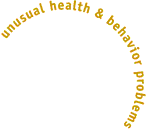|
a strange website about cats and kittens |
|
   |
survey
| survey results | my
opinion | what I feed my cats
My Theories of Cat FoodInstead of telling everyone exactly what they should be feeding their cats, I am providing a few simple theories of what comprises quality cat food as a general guide to help cat owners choose cat food. If you're curious, here's what I feed my own cats. 1. You get what you pay for (kind of) So some of the cheaper brands do cut corners. They use meat deemed "unfit for human consumption." The meat may be from a diseased or prematurely dead animal. It could also be rotten, or contaminated by feces or other undesirable materials. Cat food can also contain the bodies of cats and dogs euthanised at shelters and pounds. There are no regulations to prevent this--consumers can only research, ask questions and avoid buying cheap cat food. On the flip side, there are fairly expensive cat foods that aren't especially good quality. Take Fancy Feast, for example. It is a typical supermarket-quality brand, but it has a big advertising budget that tries to convince you that you'll be more cultured if you feed your cat this food. Also, the tiny cans mean that you are paying extra for all that adorable packaging. So I decided to ask a few cat food companies about their ingredients:
To save money on canned cat food, buy the biggest cans that you can use without the cat food spoiling. (To keep the leftover food to be used for the next meal, you could dump the cat food into a glass Pyrex container, cover it with a plastic lid and place it in the fridge.) 2. If eating an all canned/dry food diet isn't good for humans, why is it good for cats? The pet food industry tells us that the best thing we can feed our cats is dry or canned cat food. Yet, we humans are told to eat as many fresh foods as possible, avoiding processed and canned foods. If you ate only canned or dry food every day for your entire life, how would you feel? Healthy and energetic? Or tired and sluggish? Before pet food was developed, people fed their dogs and cats table scraps. Do cats and dogs live longer, healthier lives now that we feed them pet food? Surprisingly, they do not; while human life spans have increased dramatically, dog and cat life spans have stayed about the same. When you think about the medical advances that have been made to benefit our pets, doesn't it make sense that the life spans would increase? I don't think feeding table scraps is the solution. For one, most of what people eat nowadays is processed food--so it's worse than feeding your cat canned or dry cat food. One option, if you have the time, is feeding your cat a homemade diet. But do some research first. Ideally, you would describe your proposed diet to your vet before putting your cat on it. There are quite a few homemade diets available, and some are probably not appropropriate for your cat. I would like to recommend some diets/web sites for this, but don't know enough about it to list any.
|